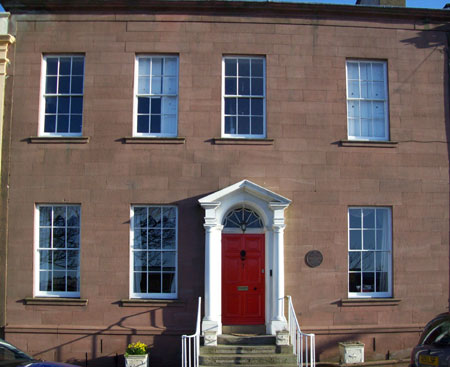
Dr. John Fletcher Miller, respected 19th Century meteorologist and Fellow of the Royal Society, was born in Whitehaven on 20th June 1816, and lived there for the rest of his life. His parents William and Mary were Quakers and for his education they sent him to the Kendal school of Samuel Marshall where that other famous Cumbrian scientist, John Dalton, had once been master. It was there, no doubt, that his enthusiasm for science was kindled and from the age of 15, like Dalton before him, he started to keep a daily weather record. This he continued until near his death, with little interruption and with great accuracy and perseverance.
Although his father was a tanner who owned the large tannery at the top of Scotch Street it appears that John disliked business and preferred to devote himself to science. His instruments were set up in his garden at the back of High Street.

The house on High Street Whitehaven where John Fletcher Miller lived and recorded his experiments.
The summary of his weather recordings he published in the Edinburgh Philosophical Journal each year along with other observations such as particular lightning storms and falls of snow. He also included in these summaries the health of Whitehaven, agriculture and other natural phenomenon. [more on his experiments]
Around the year 1837 he was elected as a member of the Meteorological Society for whom he recorded observations on a journey to Sydney, Australia, where he stayed several months. This voyage, started in October 1837, was with the hope of improving his health as he had suffered daily pain since the age of 16. He returned over a year later via Valparaiso in Chile.
In 1844 he became aware of the high rainfall in the lake district and set up over 26 rain gauges at various locations and in 1846 at different altitudes. His startling results indicated rainfall at some locations even higher than in tropical zones and that precipitation increased up to an altitude of 2000 feet after which it decreased. His highest gauge was on top of Scafell Pike and it is thought he paid shepherds to take the measurements. The list of those with whom he corresponded was over 250 and he was considered one of the foremost meteorologists of the day. In 1847 the Royal Society voted to give money to assist his experiments - his first paper to be read to the Society was on the 18th May 1848. After another paper he was elected a Fellow of the Royal society in 1850 and 5 of his papers were published in their transactions. That year he published a paper entitled "The Relation of the Air and Evaporation Temperatures of the Dew Point as determined by the Greenwich Tables, and by actual observation with a Daniel's' Hygrometer". In it he verified by experiment the accuracy of tables produced by another Fellow, J. Glaisher, of the Greenwich observatory.
His science was not only limited to the weather as he was also a keen astronomer and was elected a member of The Royal Astronomical Society in 1849. That year he built an observatory with a rotating conical roof between High Street and what is now St. James Junior School.

Miller's observatory on Wellington Row taken from a postcard and tinted in Photoshop.
The telescope was made by the best English manufacturer, Thomas Cooke of York, and was a very large one for the period, being a 9.5 inch refractor on an equatorial mount. It also had a fine wire micrometer that enabled him to do very careful measurements of double-stars; this was considered to be one of the most exacting tasks of astronomy at the time. His results were regularly published in, what became the oldest astronomy journal, "Astronomische Nachrichten" and also the Royal Astronomical journal. Also working on double stars at the time was Isaac Fletcher of Tarn Bank, a cousin of John's who later became M.P. for Cockermouth. John was a signatory of Isaac's Royal Society certificate.
John, a good communicator, often gave lectures in Whitehaven on scientific subjects and welcomed those interested to his observatory. Though sometimes seen as slightly distant, he could also be very engaging socially, willing always to lucidly impart some of his extensive literary as well as scientific knowledge to anyone he was with.
Prior to his death he was collecting material for an all-encompassing work on the Lake District that would include its geology, botany, ornithology, and entomology with particular emphasis on the plants and insects unique to the mountains.
Added to this varied catalogue of interests, John Fletcher Miller apparently also possessed a great knowledge of medicine and anatomy, possibly from investigation of his own illness. He intended to qualify as a doctor when he entered himself at Guys Hospital in October 1855. Unfortunately, this was never to be and it was a great loss to mankind that his life ended at such a young age. One can only imagine the amount of research he could have produced with another 40 years like his predecessor William Brownrigg.
John Fletcher Miller died after a short illness at the age of 40, on the 14th of July 1856, at his father's house in High Street. He was buried at the then new cemetery allotted to the Society of Friends, although he was recorded as a non member.
The Cumberland Paquet carried an obituary summing up his life's achievements and amongst his qualifications that he was:
Doctor of Philosophy and Master of Arts of the University of Gottingen,
Fellow of the Royal Society,
Fellow of the Royal Astronomical Society
Associate of the Institute of Civil Engineers (Life Associate)
Member of the British Meteorological Society
Member of the Manchester Literary and Philosophical Society
and was honorary member of many others.
ref: Minutes of Institution of Civil Engineers (1856-7)
Cumberland Paquet 1856
Whitehaven - Daniel Hay
© WAWL 2008